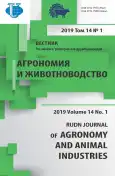THE RESULTS OF THE EMBRYO TRANSFER TO HEIFERS FROM THE AYRSHIRE BREED
- Авторлар: Nimbona C.1, Kulikova N.I1, Butore J.2, Ntunzwenimana M.2
-
Мекемелер:
- Kuban State Agrarian University
- University of Burundi
- Шығарылым: Том 14, № 1 (2019)
- Беттер: 66-72
- Бөлім: Veterinary science
- URL: https://journal-vniispk.ru/2312-797X/article/view/329133
- DOI: https://doi.org/10.22363/2312-797X-2019-14-1-66-72
- ID: 329133
Дәйексөз келтіру
Толық мәтін
Аннотация
Dairy cattle’s breeding is an important industry, since it is providing milk and meat to population. Modern cows are significantly different from their ancestors in biology, behavior and in productivity. The scientific approach to feeding, condition of content and formation of focused heredity contributed to increasing the cows’ productivity. During the mammary gland formation and sexual cycles manifestation, puberty occurs, which makes it possible to obtain offspring and secretion of milk for feeding calves. The modern cows are capable of producing milk for their calves and for feeding people. The appearance of record cows, giving about 100 kg per day, and during lactation more than 32 tons of milk serves as an example for achieving such indicators of production. There are negative effects in reproduction biology, which takes place in modern cattle breeding. In order to breed highly productive cows, it is important to increase their livestock by intensive selection. Modernity is such that fertility is reduced due to cows’ reproductive functions inhibition. Modern practice shows that it is possible to introduce methods of obtaining several calves from one cow. It is generally accepted for this purpose use new reproduction methods, for example transplantation of embryos with high genetic potential. This technique is widely used in biotechnology of cows breeding. We have tested the method of preparing and conducting embryo transfer to heifers from 13 to 16 months old in the Kuban Agro-Association. The article presents indicators of heifer. It was revealed that not all animals reacted positively to superstimulation. Embryo transplantation showed that 35.1% of embryos survived after embryo transfer. Economic calculations have shown that for the rapid formation of a highly productive herd on the farm, it is advisable to use Ayrshire breed heifers capable of raising embryos and giving birth to healthy calves as recipients.
Негізгі сөздер
Авторлар туралы
Constantin Nimbona
Kuban State Agrarian University
Хат алмасуға жауапты Автор.
Email: conim120@yahoo.fr
DVM, M.Sc., PhD student, Department of Private Zootechnics and Pig farming, Faculty of Zootechny
Krasnodar, 350044, Russian FederationNadezhda Kulikova
Kuban State Agrarian University
Email: kulikova_ni@bk.ru
Dr. of Agr. Sc., Professor, Department of Private Zootechny and pig farming
Krasnodar, 350044, Russian FederationJoseph Butore
University of Burundi
Email: butojo07@yahoo.fr
DVM, PhD, Department of Agronomy and Bio-engineering
Bujumbura, 1233, BurundiMelance Ntunzwenimana
University of Burundi
Email: ntunzwe@yahoo.fr
DVM, PhD, Department of Agronomy and Bio-engineering
Bujumbura, 1233, BurundiӘдебиет тізімі
- Nimbona K, Kulikova NI, Mehonoshin MV. Selection and superovulation of cows of donors and recipients during embryo transplantation. In: Innovation in increasing the productivity of farm animals. Collection of articles on the materials of the international scientific-practical conference. Krasnodar, 19 October 2017. Krasnodar: KubGau Publ.; 2017. p. 129-135. (In Russ).
- Nimbona K, Kulikova NI. Planning the study of the formation of a selection group of cows in breeding farms using embryo transplantation. In: Collection of articles on the materials of the X All-Russian Conference of Young Scientists dedicated to the 120th anniversary of I.S. Kosenko 24-30 November 2016. Scientific support of the agro-industrial complex. Krasnodar: KubGau Publ.; 2017. p. 252-253. (In Russ).
- Roper DA, Schrick FN, Edwards JL, Hopkins FM, Prado TM, Wilkerson JB, Saxton AM, Young CD, Smith WB. Factors in cattle affecting embryo transfer pregnancies in recipient animals. Animal Reproduction Science. 2018; 199:79-83.Available from: doi: 10.1016/ j.anireprosci.2018.11.001.
- Shcherbak OV, Zyuzyun AB, Kovtun SI. Cryopreservation of embryos as a method of preserving the gene pool of white-headed Ukrainian cattle breed. Dairy and Beef Cattle. 2017; (2):21-23. (In Russ).
- Lim HJ, Yoon HB, Im SK. Relationship between growth pattern, age at first calving and next reproduction in Holstein heifers. J. Emb. Trans. 2015; 30(4):265-270. Available from: http://db.koreascholar.com/article.aspx?code=311768.
- Bó GA, Baruselli PS, Moreno D, Cutaia L, Caccia M, Tríbulo R, Tríbulo H, Mapletoft RJ. The control of follicular wave development for self-appointed embryo transfer programs in cattle. Theriogenology. 2002; 57(1):53-72. Available from: doi: 10.1016/S0093-691X(01)00657-4.
- Colazo MG, Gordon MB, Rajamahendran R, Mapletoft RJ, Ambrose DJ. Pregnancy rates to timed artificial insemination in dairy cows treated with gonadotropin-releasing hormone or porcine luteinizing hormone. Theriogenology. 2009; 72(2):262-270. Available from: doi: 10.1016/j.theriogenology.2009.02.017.
- Nabenishi H, Sugino F, Konaka R, Yamazaki A. Conception rate of Holstein and Japanese Black cattle following embryo transfer in southwestern Japan. Animal science Journal. 2018; 89(8):1073-1078. Available from: doi: 10.1111/asj.13042.
Қосымша файлдар










